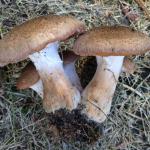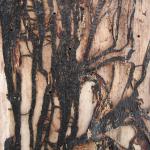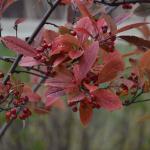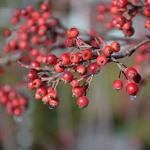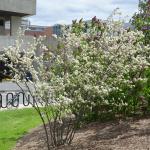A monthly e-newsletter from UMass Extension for landscapers, arborists, and other Green Industry professionals.
To read individual sections of the message, click on the section headings below to expand the content:
Hot Topics
UMass Garden Calendar Photo Contest
Ever take a great garden photo and think “this would be perfect for the UMass Garden Calendar?” We are pleased to announce that we are now accepting photos submitted by the public. Submissions will be judged by the calendar team at UMass Extension and may earn a spot in the 2019 Garden Calendar. For more information visit the Garden Calendar page.
Ticks are active at this time!
Remember to take precautions when working outdoors and to conduct daily tick checks. The UMass Amherst Laboratory of Medical Zoology tests ticks for Lyme Disease and other tick-borne pathogens. Visit the Tick Report website for more information.
Questions & Answers
Q: What is the best time to add lime into the soil?
A:Fall is the best time to add lime into the soil. Although fall marks the end of the growing season, it is the best time to modify soil pH because it allows time for the chemical reactions to occur before the next growing season.
Before adding soil amendments, it is important to test the soil. Soil physical appearance, texture, color, slope, drainage and past management practices should be similar throughout the test area. Separate samples should be collected from areas that differ. Do not collect soil samples when soil is very wet. Information on collecting soil samples can be found on the UMass Extension Soil and Plant Nutrient Testing Laboratory website.
Soil pH is a measure of soil acidity and is a important chemical property of the soil because it affects the availability of nutrients to plants and the activity of microorganisms in the soil. Most plants grow best when soil pH is between 6.0 and 7.0, except for some acid loving plants such as blueberries, azalea, and rhododendrons that require lower soil pH conditions of between 4.5 and 5.2.
Agricultural limestone is the most common material used for raising soil pH. Limestone consists of either calcium carbonate (calcium limestone) or calcium and magnesium carbonate (dolomitic limestone). In soils low in magnesium, dolomitic limestone is preferred. Apply lime as recommended by soil test results and incorporate into the soil. When lime is added in the soil, chemical reactions neutralize the active acidity (hydrogen ions in the soil solution) and exchangeable acidity or buffering capacity (hydrogen and aluminum ions held on soil particle surface) to raise the pH.
When growing acid loving plants such as blueberries and azalea lowering soil pH maybe required. Elemental sulfur is the most common material recommended for lowering soil pH. Elemental sulfur reacts slowly with soil and it is best applied in the fall and incorporated into the soil. Apply elemental sulfur as recommended by soil test results.
Q: Can I plant trees and shrubs in fall or I should wait to plant in spring?
A: Early fall is a good time to plant trees and shrubs. The soil is warmer and less damp than in the spring. Planting in early fall (mid-August to mid-October) allows enough time for the plant to establish a root system during cooler weather before the soil freezes (plants need at least six weeks to establish before the ground freezes). Keep the newly planted trees and shrubs well-watered as long the soil is not frozen. For more information on planting trees: UMass Extension Guide to Planting Trees and Shrubs
Geoffrey Njue, Green Industry Sustainability Specialist, UMass Extension
Trouble Maker of the Month
Armillaria root and butt rot
Armillaria is a soilborne, root and lower trunk rot pathogen that will preferentially attack trees weakened by stress. Insect defoliation (e.g. gypsy moth and winter moth) along with the 2016 drought weakened many landscape trees in the region, creating ideal conditions for Armillaria to initiate and expand current infections. Armillaria produces annual, fleshy mushrooms during brief periods in the fall, when conditions are cool and wet. Spores are disseminated and can initiate new infections on open basal wounds. Mushrooms are most abundant from late September through early October in our region. Rhizomorphs (black, root-like structures present in the soil) grow and expand starting in late spring and into the fall. They can be found attached to large, lateral roots just below the soil line. Symptoms of armillaria root rot can be very general. Infected trees and shrubs will show dieback of upper canopy branches, a stress cone or seed crop, basal flaring, resin/sap flow at the base, basal cankers (butt rot), and scorched or blighted foliage. Rhizomorphs will be present below the soil, attached to roots on the base of the tree. On badly infected trees, white mats of fungal tissue, known as mycelial fans, may be present beneath the bark on the cambium. If a tree is known to be infected with Armillaria, reduce additional stresses at all costs. Avoid fertilization, as the fungus will also be stimulated. Lime can be applied to increase vigor of sugar maples. Prune out dead branches that pose a hazard risk. Carefully monitor the tree going forward as Armillaria can cause significant internal decay that cannot be detected from a visual assessment along, leading to possible stem failure.
Plant of the Month
Aronia arbutifolia ‘Brilliantissima’, chokeberry
Looking for a native shrub with great fall color to replace the invasive Euonymus alatus (burning bush)? Aronia arbutifolia ‘Brilliantissima’ is a great multi-season interest plant for shrub borders, woodland, naturalized, and wet areas. Aronia arbutifolia ‘Brilliantissima’ has an upright multi-stemmed form growing 6-8’ tall and 3-4’ wide. Corymbs of small, white five-petaled flower emerge in early May and last around one week. Flowers are followed by clusters of ¼” glossy red fruits (pomes) that ripen in late summer and persist into fall and winter. Leaves are small (1.5-3.5” long), ovate, dark glossy green with serrations and pubescent gray-green undersides. Aronia arbutifolia ‘Brilliantissima’ has great, bright-red fall color, sometimes having a mix of red, purple, and orange. Chokeberry is best planted in groups and with other plants as these shrubs can be leggy. ‘Brilliantissima’ is considered to be superior to the species for having more intense red fall color, larger and more abundant fruit, and a more compact habit. It is more commonly available in trade than the species. Best fruit production and flowers occur in full sun but plants are tolerant of part shade. Aronia arbutifolia is an adaptable plant, tolerating both wet and dry soil. Birds tend not to eat the fruit due to the bitter taste. This plant is a good choice for naturalistic, native, or rain gardens.
Mandy Bayer, Extension Assistant Professor of Sustainable Landscape Horticulture, University of Massachusetts Amherst
Upcoming Events
New England Grows
New England GROWS takes place on November 29 - December 1, 2017, at the Boston Convention and Exhibition Center. For the latest information, download the GROWS mobile app; follow New England GROWS on Facebook and Twitter; visit NewEnglandGrows.org or call (508) 653-3009.
GROWS Marketing Guide: http://tinyurl.com/GROWSBrand17
Other Upcoming Events:
- 10/4: Fall Intrest Tree and Shrub ID Walk
- 11/29-12/1: New England Grows
- 1/8-2/16: UMass Winter School for Turf Managers
For more information and registration for any of these events visit the UMass Extension Landscape, Nursery, and Urban Forestry Program Upcoming Events Page.
Additional Resources
For detailed reports on growing conditions and pest activity – Check out the Landscape Message
For commercial growers of greenhouse crops and flowers - Check out the New England Greenhouse Update website
For professional turf managers - Check out Turf Management Updates
For home gardeners and garden retailers - Check out home lawn and garden resources. UMass Extension also has a Twitter feed that provides timely, daily gardening tips, sunrise and sunset times to home gardeners, see https://twitter.com/UMassGardenClip
Diagnostic Services
A UMass Laboratory Diagnoses Landscape and Turf Problems - The UMass Extension Plant Diagnostic Lab is available to serve commercial landscape contractors, turf managers, arborists, nurseries and other green industry professionals. It provides woody plant and turf disease analysis, woody plant and turf insect identification, turfgrass identification, weed identification, and offers a report of pest management strategies that are research based, economically sound and environmentally appropriate for the situation. Accurate diagnosis for a turf or landscape problem can often eliminate or reduce the need for pesticide use. For sampling procedures, detailed submission instructions and a list of fees, see Plant Diagnostics Laboratory
Soil and Plant Nutrient Testing - The University of Massachusetts Soil and Plant Nutrient Testing Laboratory is located on the campus of The University of Massachusetts at Amherst. Testing services are available to all. The function of the Soil and Plant Nutrient Testing Laboratory is to provide test results and recommendations that lead to the wise and economical use of soils and soil amendments. For complete information, visit the UMass Soil and Plant Nutrient Testing Laboratory web site. Alternatively, call the lab at (413) 545-2311.

